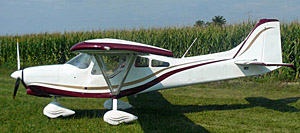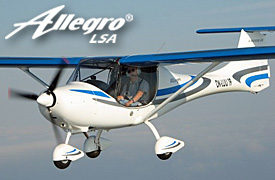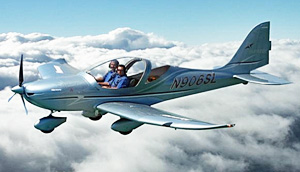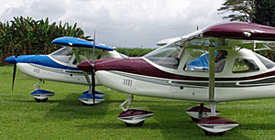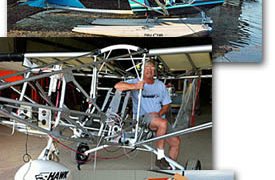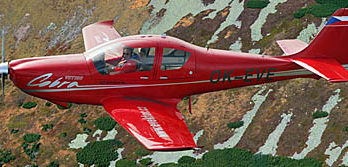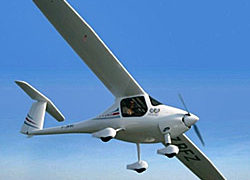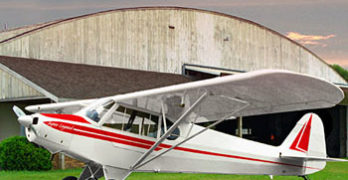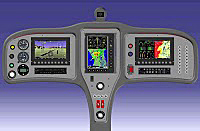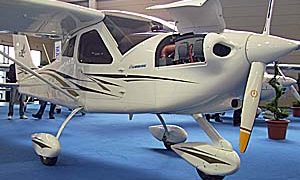Way over in Paris a new airplane has arrived just as large numbers of pilots head to Oshkosh for AirVenture. Only this Paris is in Tennessee as reviewed earlier. SLSA #120 Spirit comes from a new company but one whose leader earned his SLSA pedigree gaining four model approvals. That would be Skykits and their STOL variations. All are designs from ICP of Italy (Savannah, plus ADV and VG models of the Savannah). FAA considered them a different models so our SLSA List accepted them as such. Then Skykits brought out the Rampage, their own variation of another ICP design. *** Skykits refined those initial approvals into three birds: Savannah VG with fixed-position leading edge slats accented with vortex generators; Savannah VGW, a larger version of the VG in a wide body form with bubble doors; and Rampage with electrically-deployable leading edge slats trailed by Fowler flaps.
Allegro Keeps on Training… 3,500 Hours Logged!
LSA America now produces the Allegro in Littleton, North Carolina and anticipates their first U.S.-produced LSA approval before Oshkosh 2011. Despite Czech-based Fantasy Air’s ceasing manufacturing several years ago, Allegro did well enough in the first couple years to still retain the #14 rank. *** Exciting as this now-Made-in-the-USA story may be, this article has a different focus. I want to tell you about an older Allegro, one that has logged more than 3,500 hours, nearly all of them doing training. *** With a few other long-serving LSA that I’ve been told about, this addresses the matter about Light-Sports being durably built to perform instructional flying over an extended period. Some pilots believe lightly built LSA cannot handle the duress of students learning to fly. *** Allegro (N50631) appears to disprove the argument that LSA aren’t tough enough. New factory operator Doug Hempstead stated, “The composite fuselage has proven itself in a flight school setting and aluminum wings make [Allegro] affordable to repair.” He continued, “[Our trainer] is an Allegro 2000, the design built from 2000 to 2006.” It was put in service at B Bar D Aviation Flight School with 200 hours.
Evektor Harmony LSA Becomes SLSA #119
Evektor will always be First… that is, the Czech company gained the very first Special Light-Sport Aircraft approval back in April 2005 and no one can ever take that first-in-class title away from them. Now they are also the newest approval, before AirVenture 2011 anyway. Congratulations to Evektor Aerotechnik and their U.S. representatives including Steve Minnich’s Dreams Come True operation in Dayton, Ohio. *** “I got a call right at lunch time that the Evektor Harmony LSA, N905EH, just received her airworthiness certificate,” Steve wrote on July 13th. How is Harmony different than the SportStar series (SE, Plus, Max, Max IFR)? Steve helped out with an informative summary. *** “The wing and tail surfaces are tapered and the wings and horizontal stabilizer have greater span so the wing area is actually the same. Both rudder and ailerons are larger giving a higher crosswind capability and the rudder pedal linkages exit through the floor rather than penetrating the firewall.
Fixed wing or Flexwing; Take Your Pick
I am only aware of one company* in the USA that offers you a choice of a conventional three-axis fixed wing or a weight-shift control (WSC) flexwing. Why do this? Simple. Not all pilots want the same kind of aircraft and some of us like both kinds of flying.
It happens that the boys from Zephyr Hills airport have two interesting machines and you ought to know about them. “Boys” in this case refers to Abid Farooqui, Larry Mednick, and Phil Mednick; the latter are a son and father combo. Abid and Larry are trike guys while Phil is the fixed wing fellow and they display not only expertise, but as the impressive Revo development shows, they bring genuine creativity to the aircraft. This trio of talent operates several businesses, including a flight school.
One company, Apollo Aircraft, offers the Columbian-designed Ibis Magic as well as the Apollo LSA (formerly Apollo Fox).
The Range of LSA is Wide as the USA
Plenty of folks think LSA are mainly carbon fiber speedsters with autopilots and huge computer screen instrumentation. No doubt, we have some beauties that are equipped like luxury sport planes. If you’ve got the budget, the Light-Sport industry has the aircraft. Yet not everyone can afford those birds and not everyone wants one. *** FAA pretty much eliminated ultralights when they came out with the SP/LSA rule… well, except for genuine ultralights of the single place variety. The latter still exist, and yes, you can still buy a ready-to-fly ultralight “vehicle” for which you need no N-number, no medical, and no pilot license. Those 254-pound (max empty weight) aircraft prove America remains the land of the free and I, for one, love to fly them. *** On our way north for AirVenture my wife, Randee, and I made a series of stops. In Alabama — just a mile apart — we hit two fixed wing producers of “ultralights” that qualify as official SLSA.
Aero 2011: LSA Companies Grow… Expanding Into GA
Update 9/24/14 — Added to the models below, South Africa’s The Airplane Factory is also offering their four seat Sling 4. This model is flying but a decision about certifying it has not been made at this time. It is presently available as a kit-built airplane.
Some of the more successful Light-Sport Aircraft producers have their eye on the market for larger aircraft, those able to seat four… or more. While continuing to manufacture their LSA models, three companies showed bigger aircraft or mockups at Aero 2011 and one other company has already done extensive test flying. Look out Cessna, Piper, Diamond, and Cirrus! Those familiar GA brands are about to get new competition. *** The first of this emerging segment was the Evektor Cobra, dating back more than four years. Previously marketed at shows like Oshkosh, Cobra was promoted with alternate powerplants of 200 and 315 horsepower. Joining Cobra in the roughly 2,500-pound gross weight category (approximately the weight of a Cessna 172) are three newcomers: Tecnam’s P2010, Flight Design’s C4, and Pipistrel’s Panthera (photos).
Triple Play: Pipistrel Wins SLSA Approvals
After a pause in new SLSA, Pipistrel burst onto the scene with multiple approvals, three at once reports Michael Coates, the importer for Pipistrel USA. We raced to get these placed on the SLSA List because it’s news, but also because FAA uses this list to verify new models before assigning them N-numbers. FAA Registration Branch checks to make sure company names and other info matches incoming applications; we had three calls last week from producers who requested minor changes to our SLSA List after the agency raised questions. *** Now that list swells to 118 models. Pipistrel, which makes long-winged models that soar well, got the Virus approved in both airplane and glider categories, no small achievement. They also gained approval for their Taurus motorglider. The Slovenian company — with production facilities in nearby Italy (partly an effort to adhere to the U.S. government’s bilateral agreement requirement… dull, yes, but important legally) — has been in the news for their electric airplanes and has announced a supersleek four seater, the Panthera.
Super Legend — Lycoming Gains Among LSA
Since the beginning four brands of engines have powered Light-Sport. Rotax holds approximately a 75% share, Continental has about 15%, and Jabiru has about 10% with a couple entries using the HKS. Oh, and one more… Lycoming. *** The truth is Lycoming has literally one or two entries, the best known of which is the Falcon LS, now rebadged as the Renegade. In fact the latter just installed what they say is the first O-233 true LSA engine from Lycoming. *** But the situation seems to be changing rapidly. Rotax still dominates and will for the foreseeable future; their 912 series is a well proven and well accepted powerplant. But here comes Lycoming. Besides the Renegade, Tecnam is now offering the O-233 on their Eaglet. And I’ve heard rumors of more such installations, potentially some backlash on Continental’s transfer to Chinese ownership.
What Comes Next After the Remos GX?
Remos arrived in America with their G-3 model. In 2008 the company upgraded to GX. What’s next? How about the GX NXT. Did you see that coming? *** Remos Aircraft sent out advance word that its new GX NXT will debut at Oshkosh this year. The current GX Aviator II model will not be replaced. The German company’s new NXT version reflects a new instrument panel and price (base: $129,961, a significant drop from the Aviator II). *** Dynon‘s SkyView™, as on an ever-expanding number of other Light-Sport Aircraft, provides the anchor point for the streamlined new deck, which has been reworked to bring more leg room and better visibility over the nose to the cockpit. *** SkyView’s ever-upgrading software suite combines EFIS (electronic flight info system), EMS (engine monitoring system), Synthetic Vision, and Transponder in one unit. An optional second SkyView installation is available as well as Garmin 696 and Dynon autopilot.
Aero: Lycoming Coming to More Light-Sport Aircraft
While the Continental O-200 engine — used in several Light-Sport Aircraft — attains Chinese ownership, Lycoming appears to be making a stronger push to enlist LSA manufacturers. *** One example at Aero 2011 was the upgraded Tecnam Eaglet, which airshow visitors could compare with either Rotax or Lycoming O-233 power. The appearance difference was significant and may test the market for preference for the European Rotax engine that powers 75% or so of all LSA versus the standard bearer Lycoming that has hauled generations of Americans through the skies. *** A major difference is the air-cooled Lycoming versus the liquid-cooled Rotax. Those big fins to cool the Lyc’ demand what one Tecnam rep’ called “power bulges.” The effect on the nose cowl surrounding the engine is dramatic and I’ll bet pilots like one or the other better… which is exactly the point. Tecnam will continue building both so you can — as Burger King puts it — “have it your way.” *** The company has also upgraded the interior of the Eaglet, launched at Sebring 2009, with a highly finished interior complete with new interior door treatments (photo).
- « Previous Page
- 1
- …
- 22
- 23
- 24
- 25
- 26
- …
- 52
- Next Page »


